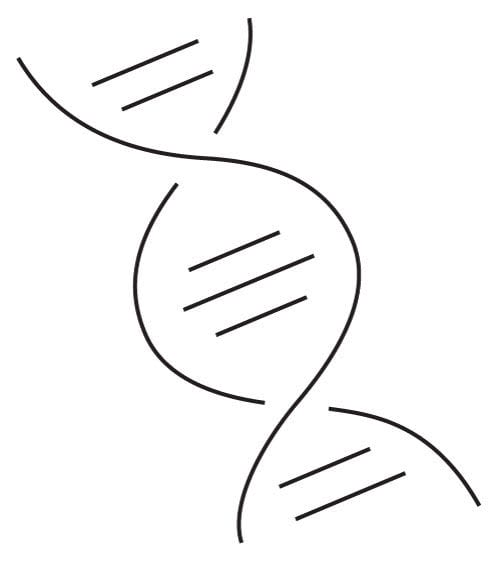What Are DHT Blockers and How Do They Prevent Hair Loss?

Until you start researching hair loss (and how to stop it), you don’t hear a lot about DHT. But then, when you do start researching the topic, “DHT” and “DHT blocker” is everywhere. And you finish your internet search with questions that range from “Um, but what is DHT exactly?” to “Can this really stop me from balding?” to “Why didn’t I pay more attention in biology class?”
While we can’t provide tons of insight into your biology class, we can help you understand DHT and DHT blockers a little better.
Long story short: DHT, or dihydrotestosterone, is a male sex hormone that binds to receptors in your scalp and causes hair loss that leads to male pattern baldness (a.k.a. androgenic alopecia) in genetically-susceptible men. DHT blockers are medications and supplements that, yep you guessed it, block DHT.
Want more quick facts on this topic? Keep reading and we’ll answer all your questions.
What exactly is DHT?
DHT is an androgen (male sex hormone) which is made from testosterone in the prostate, testes, and certain other tissues. It’s needed to develop and maintain male sex characteristics, such as a deep voice, facial hair, and muscles.
Testosterone converts to DHT with the help of 5α-reductase (pronounced 5-alpha-reductase), an enzyme that is held in the oil glands of a hair follicle.
If you’re genetically prone to male pattern baldness, DHT binds to receptors in your hair follicles, causing the follicle to miniaturize (which basically means shrink) and, eventually, to stop new growth altogether.
While research has proven that genetics plays a big role in male pattern hair loss, we still don’t know why this runs in some families and not others.
How long does it take DHT sensitivity to cause total baldness?
The good news is that this doesn’t happen overnight. To fully explain this, we should take a step back to discuss the four stages of hair growth that are always happening on your head:
- Anagen Phase: The growth phase that usually lasts from two to six years.
- Catagen Phase: The transition phase that only lasts for a few weeks.
- Telogen Phase: The resting phase that lasts for about three months.
- Exogen Phase: The shedding phase that usually results in 100-150 hairs falling out each day.
The hair is lost during the exogen phase when the follicle produces a new hair that pushes out the old one.
As androgenic alopecia sets in, follicles gets smaller and smaller making it harder for hair to grow (thanks DHT), the anagen phase gets shorter (less time for hair to grow), and the telogen phase gets longer (more time for follicle to rest without producing a new hair).
However, baldness is a slowly progressive process that usually takes place over several years.
That means you have time to stop DHT from shrinking those hair follicles and that the earlier you take action, the more hair you’ll keep.
That’s where DHT blockers come in.
Can you tell me more about DHT blockers?
We can! While you can go down an internet rabbit hole and read about all kinds of “DHT blockers,” there’s only one that’s proven to work. And that one is finasteride. Finasteride (generic Propecia®) is a prescription tablet that effectively blocks DHT and stops further hair loss, including receding hairlines. It works by binding to the 5α-Reductase enzyme, effectively inhibiting your body from producing DHT in the first place.
OK—but do DHT blockers really work?
Yes! DHT blockers are the most effective hair loss treatment. A study by the American Academy of Dermatology found that finasteride is effective at DHT blocking.
Not only does it halt hair loss, but it can even help with future growth. Another study, this one published by the Journal of Investigative Dermatology, showed that up to 83% of men taking finasteride 1mg preserved their original hair follicle counts and 66% experienced some regrowth.
Those are pretty great numbers when it comes to both stopping loss and kickstarting healthy regrowth.
Can I naturally reduce DHT?
Not everyone who wants to lose less hair is ready to get a prescription, and that’s understandable. And the internet will lead you to believe that everything from shampoos to supplements to emu oil can block DHT.
While some potential natural DHT blockers—like biotin, pumpkin seed oil, green tea, and saw palmetto—have big reputations among guys with male pattern hair loss, in clinical studies they have more of a mixed track record. Check out our guide to find out which ones are worth your time.
Despite all the excitement about some natural treatments, the DHT blocker with the most scientific evidence behind it is still finasteride.
Let’s recap: DHT is the primary hormone responsible for male pattern baldness. While there are lots of so-called DHT blockers out there, the only one that’s clinically proven to work is finasteride.
That makes finasteride the best way to prevent hair loss. And, not to brag, but we think we’re the best place to get it. Click here to buy affordable finasteride—it’s a prescription medication, so you’ll need to complete a doctor consultation to get it.
The information provided in this article is not a substitute for professional medical advice, diagnosis, or treatment. You should not rely upon the content provided in this article for specific medical advice. If you have any questions or concerns, please talk to your doctor.
If you’re experiencing a mental health crisis, please call 911 or go to your nearest emergency department. If you are contemplating suicide, call 911 or call/text the National Suicide and Crisis Lifeline at 988. These services are available 24/7.
If you would like to learn more about finasteride, please see the full prescription information here. You are encouraged to report negative side effects of prescription drugs to the FDA. Visit MedWatch: https://www.fda.gov/Safety/MedWatch/default.htm or call 1-800-FDA-1088.)